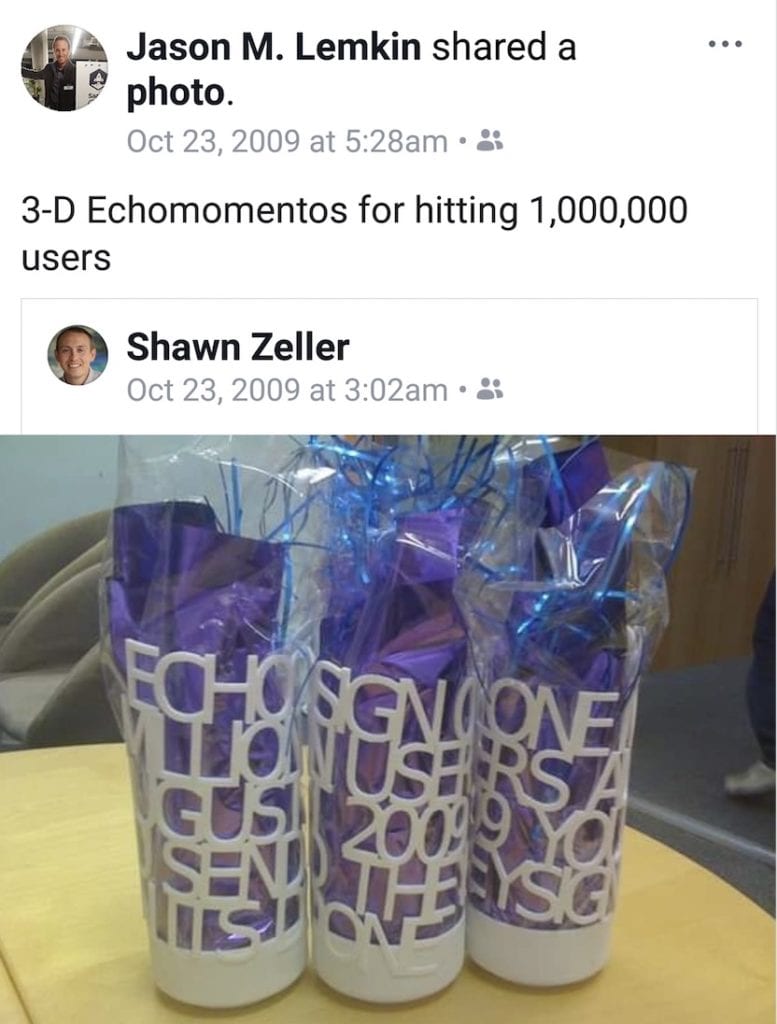Going though a slow patch is one thing
We almost all go through one or two
Settling for slow growth is another
You never really come back from that one
— Jason ✨Be Kind✨ Lemkin 🇮🇱 (@jasonlk) December 31, 2022
When I was CEO at Adobe Sign / EchoSign, I made a big strategic error in Year 1. I set a bit of an insane plan of going from $0m to $2m in ARR in our first 12 months in business. These days that happens sometimes. Sometimes. But even today, that’s pretty rare to get to $2m from initial launch.
It wasn’t because I couldn’t build a model — the model was sound. The mistake was a combination of not knowing enough about SaaS back then, and also having incredible confidence in the team’s past track record. I thought we had the best of the best and we’d hit the number for sure. There was no doubt in my mind, in fact.
And, of course, we didn’t get to $2m by Day 365. But we did hit almost $200k in Year 1. It wasn’t nothing, and it wasn’t that terrible, relative to the times, in Year 1 from launch. But the team was dejected. It quickly became clear, even with paying customers in our first weeks after launch on TechCrunch, that we’d never hit the $2m plan. And that even worse, we’d probably run out of money because of it. The team fought and squabbled and became dejected. One founder quit. Another fired another founder without talking about it first. It was tough.
I didn’t know what to do, exactly. First, I did everything humanly possible to help. I got out of the office and closed BT, Dell, GE, Qualcomm, and other leaders in Year 1. I did every piece of press and PR I could think of. I spoke at any event. I won every award you could. I found a great first VP of Marketing in Year 1. And even with all of that, it wasn’t enough.
So I came up with micromilestones out of desperation. And since then, I’ve seen other CEOs and founders successfully adopt the same strategy, especially in the $0m-$2m or so ARR days, and often even later. What is a micromilestone? It’s:
- A tangible milestone that can be hit in the next 2-6 months, given the reality of where you are today
- That supports your revenue goals for the year, but
- Is abstracted away from that longer-term revenue goal, either by metric or timing, or both.
For our first micromilestone, I moved from revenue to New Customers Per Week. The first micromilestone was 1 New Customer Every Week. That took a few months and 2 releases. The next micromilestone was 1 New Customer a Day (5 a week). The team thought I was a bit crazy, but we had a huge celebration when we hit that one. Now at least, every day we got an email re: one brand new paying customer. Sometimes they paid as little as $12/month. But getting one every single day — was something. Everyone started to get a little excited about the new customer email each day, even if they pretended it was No Big Deal.

Then I moved on to measuring us by New Seats Per Month instead of new revenue. 100 seats a month, then 500, then 1000. This made it easier for folks to see success and progress than the specific ARR that underpinned the seats, which wasn’t that huge.
And finally, I moved on to 2 more micromilestones before we outgrew them. I added New Users as one. We had a big party at 1,000,000 total users. Now, most were free and many never came back. And users aren’t paying customers and aren’t revenue. But it’s related. It was 1,000,000 exposures and uses of our product and brand. That meant we were having an impact.
And the last micromilestone was $10m ARR. Now that’s, of course, a very quantitative one and doesn’t sound micro. But as we crossed about $3m in ARR, it became clear to me — finally — that we’d make it. That we couldn’t be killed. I’d finally found a great VP of Sales, the product was finally good, and the engine was working. I just wasn’t sure how long it would take. So I set the next goal as $10m ARR. But … I didn’t pressure most of the company to hit it on a particular date. Not until we were closer. We just had fun, and each company meeting celebrated progress toward the goal. We were always winners then, as we climbed up that hill together.
The management team still had annual goals, and we still had to hit them. We held the VP+ team to strict-ish ARR goals for the year. But micromilestones helped everyone else see the success even in the tougher times.
Since then, I’ve seen other great founders move to micromilestones when they have 50, 100, 200 customers, and high NPS … but only OK growth for now. Because you’ll get there. You’ll iterate the product. You’ll add more value. You’ll drive up the deal size, and expand the offering. And improve the team. But you can’t do all of that overnight.

I’ve also now seen the opposite — so many founders that just give up on goals in tougher times. They abandon a plan at all, and/or constantly reset it down, multiple times a year, or just plain hide from any real goals. I’ve never seen that work.
Some other successful micromilestones I’ve seen:
- Going from 10 to 20 customers. Then 20 to 40. And then 40 to 100 customers. I love this one in the early days. 10 customers may only be enough money to pay for a few lunches. But going from 10 to 20 customers will double your team’s knowledge of the market. And 20 to 40 will do the same. So maybe make doubling customers in the early days a micromilestone. You can get there soon enough — and get a free team education while you go.
- Revenue under management. This one only really works with fintech or revenue management-related products. But the team gets excited when you manage $100m in revenue. Even if that’s only $500k in ARR to you.
- $100k in Bookings A Month. Then $250k. Etc. Picking a new “high water mark” for bookings in a month is a great way to align the team, even if the month-over-month growth isn’t Slack-like yet. If you closed say, $60k last month, set a micromilestone of $100k. You’ll get there at some point.
- Paying Customers. I did a bit of this, too, see above. But growing your customer number can be a way to get the team excited, even if many are small, or come and go, or downgrade, etc.
- MAUs, DAUs, etc. I don’t totally love these B2C-like metrics, but they can help keep the team engaged. After all, the more folks that use your product, all things being equal, ultimately the more folks that will buy it. Seeing strong growth in usage can show folks the light.
- Driving NPS Up to a Key Number/Goal. Driving NPS up to say, 50 can inspire the team to improve everything. This will benefit revenue. Even if it takes a little while, or even, a longer while.
- New bookings — But Just from Existing Customers. If new logo bookings slow a bit, you often at least know how to make your existing customers happier. And then you can just go ask them what you can do to earn more business. Tracking an Upsell Goal that might be easier to achieve than an overall ARR goal can help the team sometimes through a tougher patch. I.e., maybe you can add $500k in revenue from the existing base in the next 6 months. That can be an effective micromilestone for the team to rally around.
In the end, to build something big, at some point, you do have to grow like crazy. But you don’t have to on Day 1. It took Slack several years until it morphed into … Slack. The fastest growing company I’ve invested in so far, Talkdesk — 4 years from seed to Unicorn — had almost no revenue in its first 18 months. Once you have something — some real revenue — your job is to hold the team together until you all really figure the engine out. That can take quite a while.
Micromilestones can help focus the team on achievable goals in tougher times.
Then leave them behind later when you have a real engine humming.
(note: an updated SaaStr Classic post)


